Picking the correct barbell for your home gym can definitely be difficult if you’re not sure what to look for.
Luckily, I have a ton of experience with garage gym equipment, including barbells.
In this barbell buying guide, I’ll help you find the right barbell for you!
Let’s get started!
On This Page
Key Takeaways
| Considerations | General Recommendations |
|---|---|
| Type Of Training You Do | Select a barbell that aligns with your training style: powerlifting, Olympic weightlifting, or general fitness. |
| The Construction | Ensure the barbell has a high weight capacity (at least 1000 lbs) and appropriate tensile strength (150,000-190,000 PSI for general, 190,000+ PSI for heavy lifting). |
| Barbell Dimensions | Standard Olympic barbells (7.2 feet, 20kg) are versatile for most lifters. Women’s bars are typically lighter and shorter, catering to different needs. |
| Shaft | Choose the shaft diameter based on your lifting style: thicker for powerlifting (29mm), thinner for Olympic lifting (27-28.5mm). |
| Knurling | Consider the type of knurling based on your grip preference and lifting type: mild for general use, aggressive for heavy or power lifts. |
| Sleeves | Look for sleeves with a finish that suits your usage: hard chrome or stainless steel for durability, zinc for cost-effectiveness. |
| Warranty | A longer warranty often indicates better quality. Look for lifetime or extended warranties for assurance of durability and quality. |
| Price | Balance your budget with quality. Aim for a mid-range price ($200-$300) for a good mix of quality and affordability. Avoid very cheap options under $150. |
What Is A barbell?

First up, what is an Olympic barbell?
A barbell is a piece of exercise equipment built with a steel shaft as well as two sleeves to load weight onto.
They usually weigh around 45 lbs on average and have an average length of around 7 feet. Obviously, this can be much lighter/ heavier, or shorter/longer.
There are a bunch of different types of these bars for any type of lifting you like to do.
Types Of Barbells
Before we even get into all of the features you should be paying attention to, it’s important that we go over the various lifting bars out there.
Here are the main ones you should be paying attention to in my barbell buying guide.
RELATED – Different Types Of Barbells
Olympic Bar vs Standard Bar
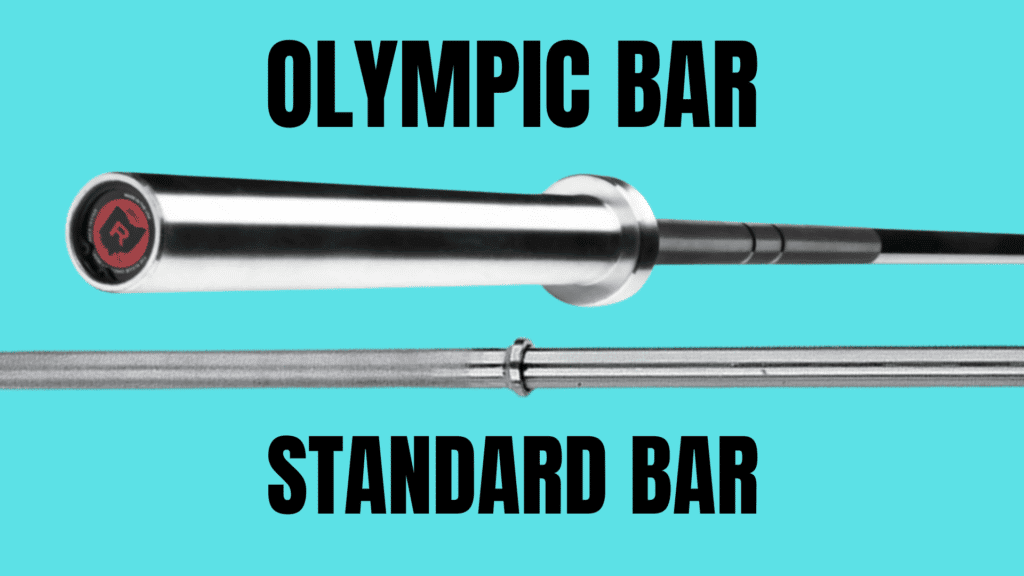
In most gyms, you’ll spot both standard and Olympic bars.
Here’s the quick lowdown: Olympic barbells are heavier, longer, more durable, and can handle more weight, making them safer for serious lifting.
Standard bars have a 1” diameter and fit only 1” plates, while Olympic bars are designed for the larger 2” plates.
If you’re just doing light training, standard bars might work, but for real strength training, go for an Olympic bar for better performance and safety.
Powerlifting Barbells
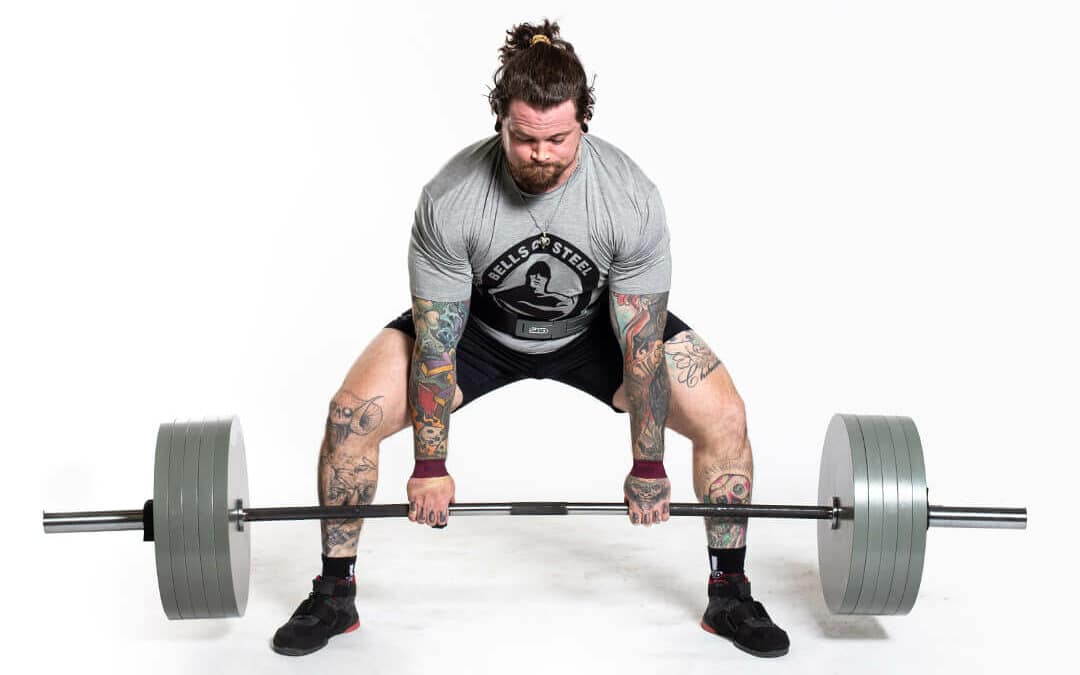
Powerlifting barbells, or power bars, are specifically designed for the Big 3 lifts: Squats, Bench Press, and Deadlifts.
They feature a 29mm shaft for extra rigidity, aggressive knurling for a firm grip, and a weight of around 20kg. Ideal for anyone focused on building strength in these key lifts.
RELATED – Power Bar vs Olympic Bar – Mastering Your Barbell Selection
Deadlift Bar
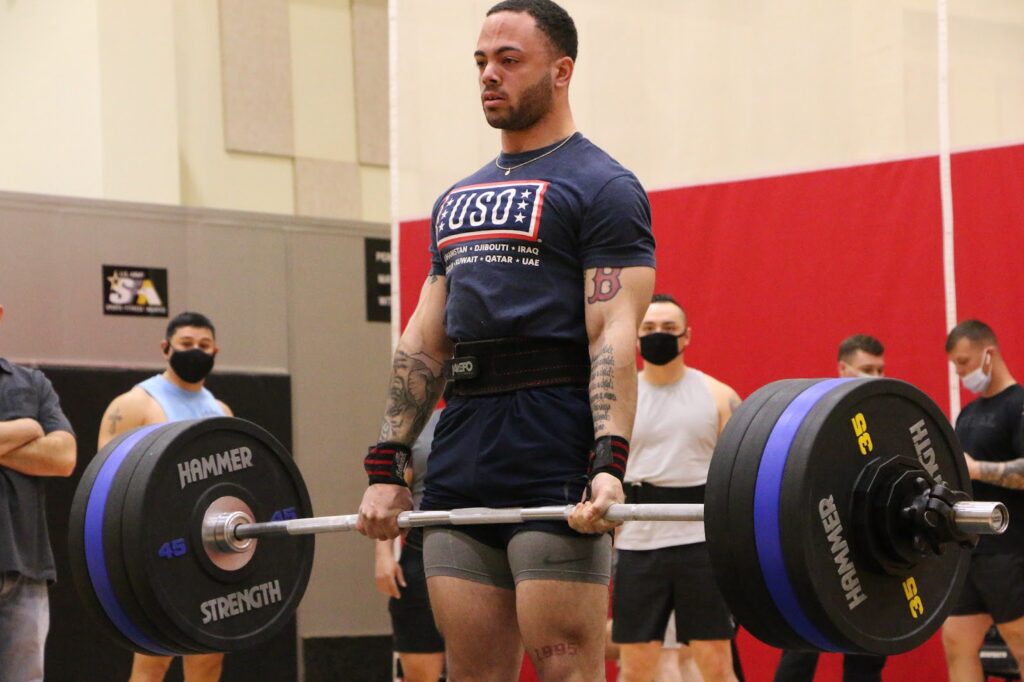
A Deadlift Bar is specifically designed for deadlifting, featuring a slimmer 27mm diameter for more whip, aggressive knurling for better grip, and a longer length to improve the starting position.
It’s ideal for heavy deadlifts, especially in powerlifting competitions.
RELATED – The Ultimate Deadlift Bar Comparison – Choosing the Right Bar for Your Lifts
Squat Bar

Specialty Squat Bars are designed specifically for squats, featuring center knurling for a solid grip on your upper back, stiffness to avoid any whip during the squat, and aggressive knurling for maximum grip.
Some, like the Rogue Squat Bar, even have full shaft knurling for extra grip. While not essential for everyone, they’re perfect for serious squatters looking to intensify their squat workouts.
Olympic Weightlifting Barbells
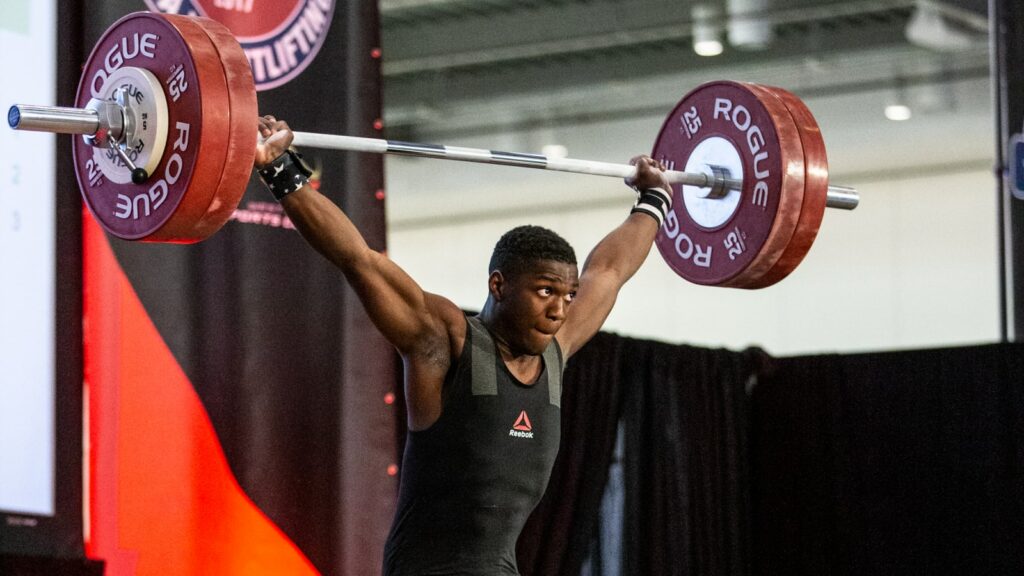
Olympic Weightlifting Bars are specifically crafted for Olympic lifts like the Clean and Jerk and Snatch.
They’re different from your standard Olympic barbells, featuring a thinner diameter for more whip, specialized knurling for grip, and fast, smooth sleeve rotation to reduce strain on your body.
Ideal for competitive Olympic lifters, but if you’re into general strength training with occasional Olympic lifts, a standard bar might suffice.
RELATED – Women’s Barbell vs Men’s Barbell
Multipurpose Barbells – CrossFit Bars/Hybrid Bars
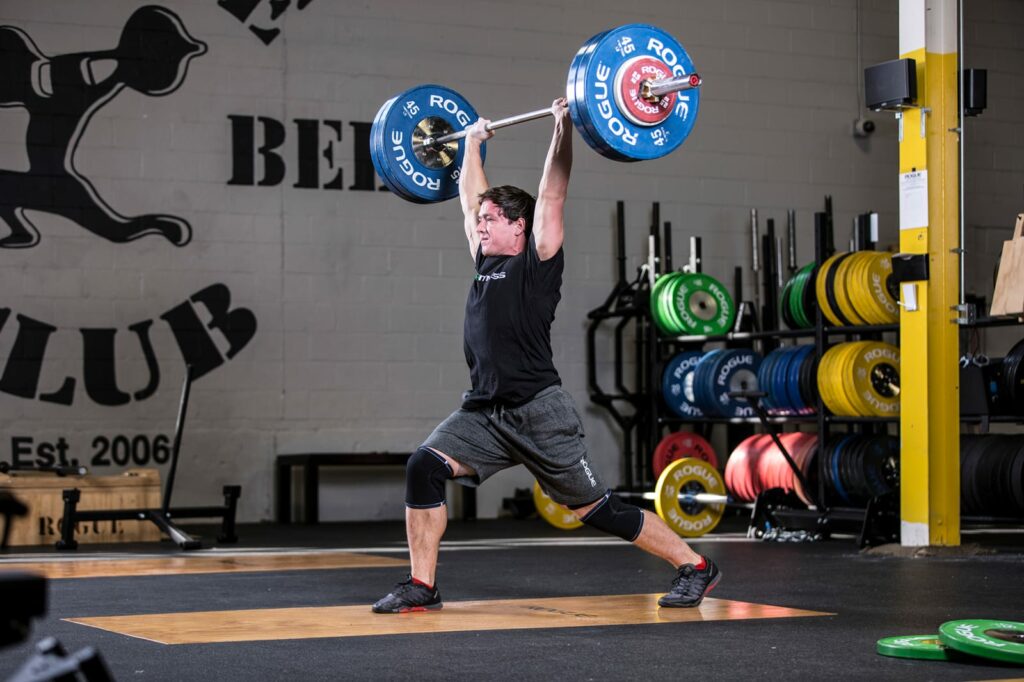
Multipurpose barbells, also known as CrossFit or hybrid bars, are your go-to if you’re looking for one barbell that handles everything.
They’re designed to be versatile enough for both powerlifting and Olympic lifting.
With a shaft diameter that strikes a balance between stiffness and flexibility, these bars offer moderate whip, making them suitable for a wide range of exercises.
They typically feature passive or no center knurling for comfort and dual knurl marks for varied grip options.
The sleeve spin, supported by durable bushings like cast bronze or composite, is smooth enough for basic Olympic lifts.
So, if you’re after a single barbell that’s up for any challenge, a multipurpose bar is the way to go.
Specialty Bars
While not as important as basic straight bars, these specialty bars open up a lot of variety in your training.
There are far more types available out there but these are the basic ones you should familiarize yourself with.
- EZ Curl Bar – Designed for bicep and tricep exercises. Its unique shape reduces wrist strain and targets arm muscles effectively.
- Trap Bar – Also known as a hex bar. Great for deadlifts and shrugs, it allows for a more neutral grip and reduces stress on the lower back.
- Safety Squat Bar – Features a padded harness and bent bar design. It’s ideal for squats, especially for those with shoulder mobility issues.
- Swiss Bar – Also known as a football bar. It has multiple grip options, perfect for various pressing and rowing exercises, and is easier on the shoulders.
What To Consider When Choosing A Barbell
Alright, let’s get into what you need to think about when picking out a barbell. It’s not just about grabbing the first one you see or the one with the coolest look.
You’ve got to consider what you’re using it for, your lifting style, and what your goals are.
Let’s break down what to keep in mind to make sure you’re choosing the best barbell for your training.
Type Of Training You Do
Your lifting style will determine what type of Olympic bar you need.
Do you compete in Powerlifting? Better get a powerlifting barbell.
Are you an Olympic Weightlifter? Time to invest in a Weightlifting Bar.
If you just lift to get stronger, build muscle, and stay in shape – get a multipurpose bar to cover all your bases.
The Construction
When it comes to the construction of a barbell, there are several critical factors to consider.
These elements determine not just the barbell’s durability and longevity but also its safety and effectiveness in your training.
Let’s dive into the essential construction features you should evaluate.
- Weight Capacity – Aim for a barbell with a minimum capacity of 1000 lbs. This is a benchmark for quality. However, don’t just take the company’s word for it; look for positive reviews to verify its reliability.
- Tensile Strength Rating (PSI) – This measures the bar’s breaking point under pressure. Opt for a barbell with a tensile strength between 150,000-190,000 PSI for general use. For the best durability, choose barbells with a tensile strength of 190,000+ PSI.
- Yield Strength Rating – This indicates when a bar permanently bends. It’s a crucial but often unreported spec. While it’s harder to find, it’s a more accurate measure of a barbell’s strength than tensile strength alone.
Recommendations
- General Training – A barbell with a tensile strength of 150,000-190,000 PSI is sufficient.
- Heavy Lifting & Longevity – Choose barbells with 190,000+ PSI for the best construction quality.
- Safety & Durability – Verify weight capacity claims with user reviews and look for any available yield strength ratings.
Barbell Dimensions
Alright, let’s break down barbell dimensions – we’re talking overall length and weight here.
These aren’t just random numbers; they’re key to fitting your barbell into your workout space and matching it with your lifting game.
- Overall Length – Your typical Olympic barbell is about 7.2 feet long. This is pretty much the standard for adult lifters and fits well in most power racks. But if you’re working with a tighter space or have a specific lifting style, you might want to look at women’s or specialty bars, which usually run shorter, around 6.5 feet.
- Weight – For the guys, most barbells hit the scales at around 20kg – solid for a wide range of strength training. Ladies, you’re looking at bars around 15kg, easier to maneuver and in line with what you’d find in women’s lifting competitions.
So, when you’re picking a barbell, think about where you’re lifting and how you’re lifting.
Make sure the length and weight of the barbell align with your space and your strength level.
Shaft
The shaft of your barbell is crucial in determining its flexibility, grip, and suitability for different types of lifts.
Here’s a quick guide to understanding the shaft’s features and making the right choice for your lifting style.
Shaft Diameter & Whip
- Diameter – Affects the bar’s whip. A thicker shaft between 29-32mm is stiffer, ideal for Squats and the Bench Press. A thinner shaft between 25-28.5mm offers more whip which is better for Olympic lifting and Deadlifting.
- Strength Ratings – Higher PSI means a stiffer bar. Lower tensile strength bars tend to whip more.
- Load – Heavier loads increase whip. Power bars need to be thicker to minimize whip under heavy weights.
- Plate Position – Weight further from the center increases whip. Wider bumper plates cause more whip than closer, thinner iron plates.
Recommendations
- Powerlifting – Opt for a stiffer, 29mm power bar. It minimizes whip for stable, heavy lifts.
- Deadlifting – A 27mm deadlift bar is ideal, offering the right amount of whip to aid the lift.
- Olympic Lifting – Choose a bar with more whip to utilize momentum and ease the catch in lifts like the Snatch or Clean & Jerk.
- Multipurpose Use – A 28.5mm bar provides a good balance of stiffness and whip, suitable for both power and Olympic lifts.
Select your barbell’s shaft diameter based on your primary lifting style and hand size.
Power bars for heavy, stable lifts; whippier bars for dynamic Olympic lifts; and multipurpose bars for a bit of everything.
Shaft Finishes
The overall finish of your barbell is incredibly important for overall performance, rust prevention, and just how cool an Olympic bar looks.
It does matter to some lifters after all!
Also, it should be obvious that not all Olympic barbell finishes are created equal!
- Hard Chrome – Resistant to oxidation, great for high humidity. Durable against wear and tear. Thicker finish can soften knurling, so opt for aggressive knurling. Watch out for cheap imitations.
- Bare Steel (Carbon Steel) – Offers the best natural grip due to no finish. Cheaper but requires more maintenance to prevent rust. Ideal if you’re okay with regular upkeep.
- Bright Zinc – Excellent oxidation resistance in low/moderate humidity. Less natural feel than hard chrome. Choose a bar with more aggressive knurling to compensate.
- Black Zinc – Aesthetically pleasing but less grippy and durable than bright zinc. Fades faster. More about looks than performance.
- Cerakote – Customizable colors, good oxidation resistance. Can chip more easily than hard chrome. Great for personalizing your gym but check durability.
- Black Oxide – Offers solid grip, thin finish maintains knurling. Cheapest option but high maintenance and fades over time. Good if you don’t mind upkeep.
- Stainless Steel – Low maintenance, naturally rust-resistant. Offers excellent grip and feel. Pricier but worth it for durability and low upkeep.
Recommendations
- High Humidity – Go for hard chrome or stainless steel.
- Best Grip – Bare steel or stainless steel, but be ready for maintenance with bare steel.
- Budget-Friendly – Black oxide, if you’re up for the maintenance.
- Aesthetics & Customization – Cerakote for color variety, but check for chipping.
- Overall Durability – Stainless steel for the best balance of feel and low maintenance.
RELATED – Zinc vs Chrome Vs Cerakote vs Stainless Steel Barbell + Other Barbell Finishes!
Knurling
The knurling of a barbell is by far one of the most critical factors you need to consider. This is what you use to grip onto the bar, after all, so it’s just a little important, you know?
There are different types and aggressiveness of knurling, as well as center knurl and knurling marks.
Let’s cover them now.
Knurling Type
There isn’t just one type of knurling, they definitely vary based on the bar and it’s purpose in training.
- Hills (Mild/Passive Knurling) – The gentlest type, often found on gym Olympic bars, multipurpose, and Olympic weightlifting bars. It’s flatter and less sharp, offering a comfortable grip without being too aggressive.
- Volcanoes (Medium/Moderate Knurling) – Characterized by a four-point pattern with a crater-like center, resembling a volcano. It strikes a balance between grip and comfort.
- Mountains (Aggressive Knurling) – The most intense knurling, resembling mountain peaks. It’s sharp and provides a strong grip, biting into your hands for maximum hold during heavy lifts.
Center Knurl
Depending on the type of lifting you do, you may or may not want a center knurling.
- No Center Knurling – Ideal for Olympic lifts and Deadlifts where center grip isn’t needed. Not recommended for Squats.
- Passive Center Knurling – Perfect for multipurpose bars. Offers enough grip for Squats without being too harsh for Olympic lifts.
- Aggressive Center Knurling – Common in power bars, best suited for Squats where maximum grip is crucial.
Knurling Marks
The knurl marks on an Olympic barbell are important as they allow you to set your grip up evenly without eyeballing it.
They’re easy to spot as smooth marks inside of the lifting bars knurling.
There are only a couple of different versions available for the basic barbell types.
- IPF Knurl Marks – Found on powerlifting bars, set 810mm (~32”) apart. They indicate the maximum hand placement for bench presses, ensuring your index finger at least covers these marks.
- IWF Knurl Marks – Present on Olympic weightlifting bars, spaced wider at 910mm (~36”) apart.
- Dual Knurl Marks – Feature both IPF and IWF marks, a clear indicator of a multipurpose bar suitable for various lifting styles.
These marks are essential for proper hand placement and adherence to lifting standards, especially in competitive settings.
Sleeves
Barbell sleeves are what you slide the weight plates onto and hold the weights while you’re training.
Of course, you have to consider the rotation system of the sleeves, whether they use bushings or bearings, and even the overall loadable sleeve length.
This section of my barbell buying guide will cover all of the key points you should pay attention to when it comes to barbell sleeves.
Coating
Unlike shaft finishes which come in a wide range of options, sleeve finishes are a little more limited.
- Common Finishes – Bright zinc and hard chrome are the most typical. You might also come across black oxide, cerakote, and stainless steel.
- Recommendations – Stick to hard chrome, stainless steel, or zinc finishes for better durability and resistance. While colored sleeves like black powder coats and cerakote look great, they tend to wear out faster with regular plate loading and unloading.
Loadable Sleeve Length
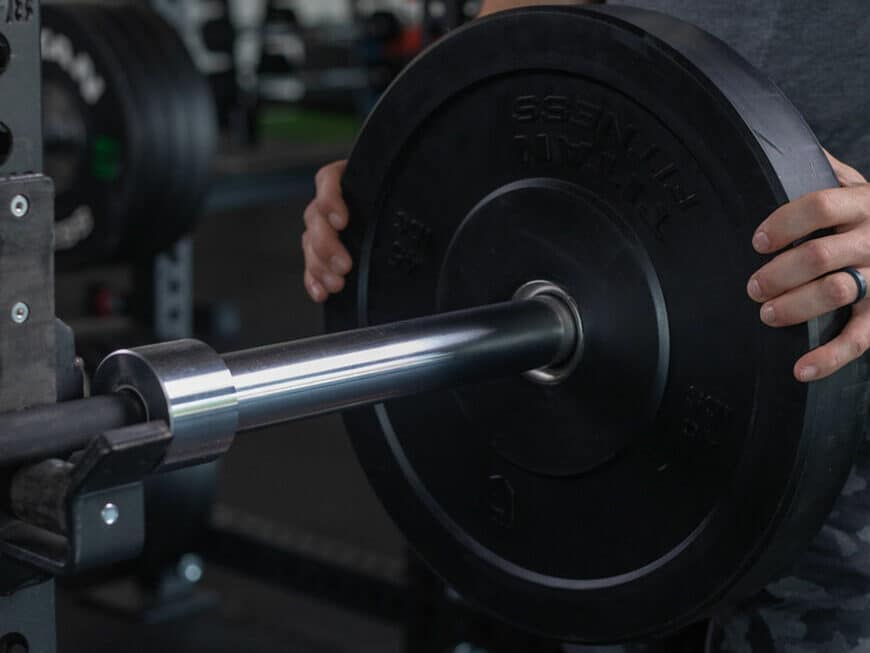
Another aspect that often gets overlooked is the loadable sleeve length.
This is the part where you’re stacking up those plates, and it’s super important to make sure it matches your lifting style and the type of plates you’ve got.
- Purpose – The loadable sleeve length is the part where you stack your weight plates.
- Plate Type – Thicker bumper plates require longer sleeves. Standard iron plates are less demanding.
- Typical Lengths – Power bars usually offer 16.25”-17” sleeves. Multipurpose/Weightlifting bars range from 16”-16.5”, and women’s bars are about 13”.
Smooth VS Grooved
Smooth sleeves are slick and can make loading and unloading plates a breeze. They’re great if you’re frequently changing weights.
On the flip side, grooved sleeves have a bit more grip to them, keeping those plates more securely in place, especially if you’re not using collars.
But remember, they can be a bit noisier and might wear down your plates faster.
Rotation System
The rotation system of your bar is super important but often doesn’t get the attention it deserves.
The way your barbell rotates can seriously make or break your lifting performance. It’s not just about how smoothly it spins; it’s about the control and safety it offers during your lifts.
Bushings

Barbell bushings are basically just solid metal rings that allow the bar to spin freely.
There is typically a minimum of two bushings per side of the sleeves.
Bushings are going to be used for most powerlifting bars and multipurpose barbells.
- Cast Bronze – Durable but requires maintenance for smooth spinning. Common in power, CrossFit, and multipurpose bars. Good choice if you’re okay with occasional upkeep.
- Sintered Bronze – Top-tier option. Durable and self-lubricating due to their porous structure. Ideal for long-lasting, low-maintenance bars.
- Composite – Offer great value. Self-lubricating with high impact resistance. A solid choice for regular use.
- Brass – The least desirable due to lower performance and durability. Requires lubrication and is prone to deformation. Avoid unless on a tight budget.
- Usage – For longevity and minimal maintenance, go for sintered bronze bushings. If budget allows, avoid brass bushings for better durability and performance.
Bearings

Let’s talk about the bearings in Olympic weightlifting bars. This might seem like a small detail, but trust me, it makes a huge difference in your lifting.
The type of bearings in the bar affects how smoothly and quickly it rotates, which is super important in Olympic lifting.
- Needle Bearings – The go-to for Olympic weightlifting bars due to their durability and ability to handle high impact forces. They ensure a fast and smooth rotation.
- Ball Bearings – Less common and not as durable as needle bearings.
- Usage – Essential for competitive Olympic weightlifting. If your focus is mainly on powerlifting with occasional Olympic lifting, a multipurpose bar with adequate rotation is more cost-effective and suitable for general use.
Warranty
This is important for deciding what Olympic barbells to invest in. The better the warranty, the better the quality of the bar should be.
If an Olympic barbell has a lifetime warranty like what is usually offered by companies such as Rogue Fitness, you can be confident you have a high-quality bar.
Price
There are a ton of great Olympic barbells for less than $200 up to $500+. However, I do think if you’re going to invest in a solid bar, anything less than $150 isn’t a great idea.
Just raising your budget into the $200-$300 range will get you a solid bar for any type of lifting you plan to do.
Frequently Asked Questions
Conclusion
Alright, that’s the lowdown on choosing the right barbell. Remember, it’s all about matching the bar to your lifting style and goals.
Whether you’re a powerlifter, an Olympic lifter, or just hitting the gym for general fitness, there’s a perfect barbell out there for you.
Consider the key points we’ve covered – from the type of knurling to the sleeve finish – and you’ll be set.
Until next time,
-Dante